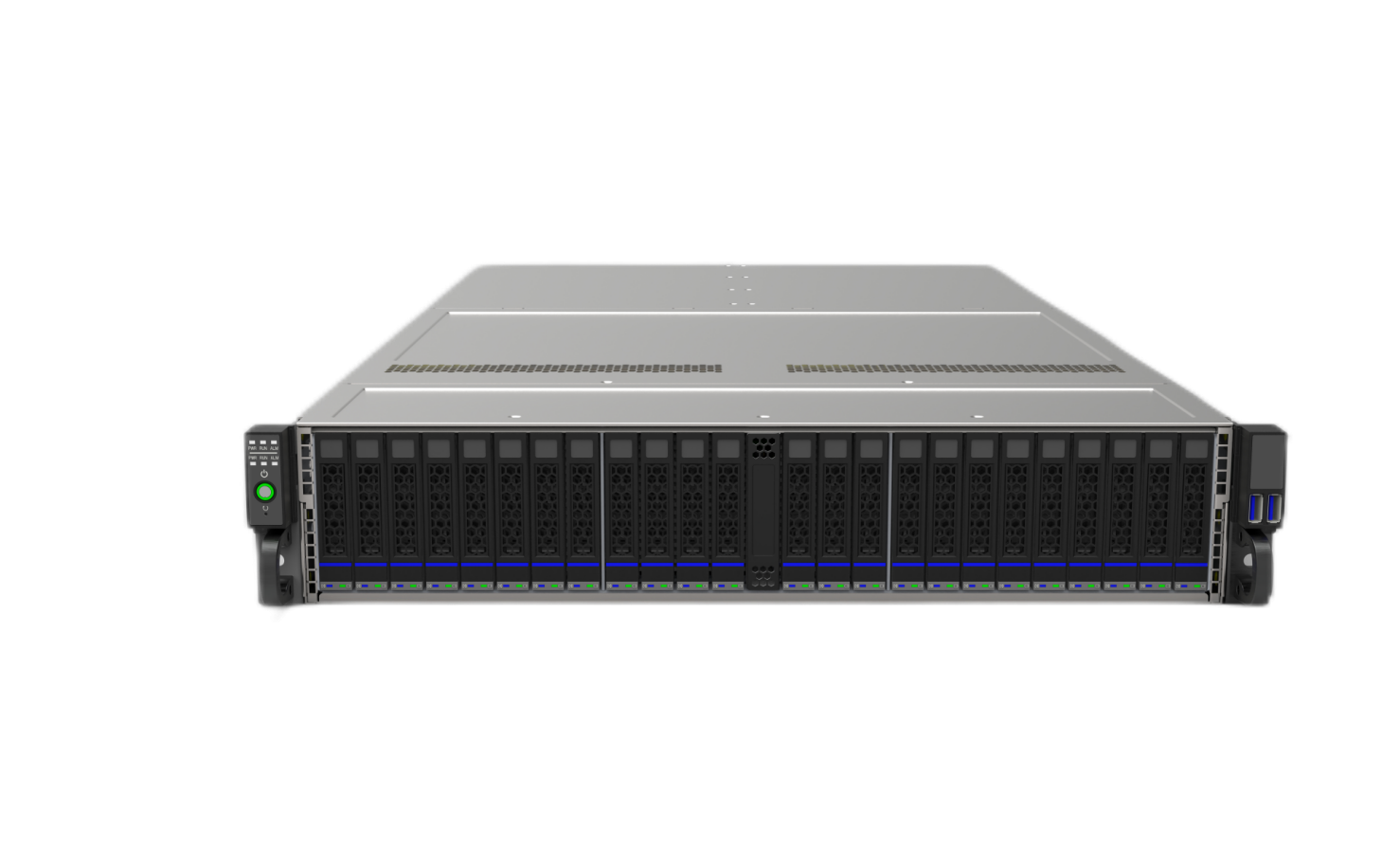MPS5000 Series NVMe Storage
The MPS5000 is a high-performance and highly reliable all-flash storage product developed by Maipu for the core business of enterprises. It adopts a new-generation hardware platform and an end-to-end NVMe architecture, and is composed of storage controllers, disks and various types of cables. On the storage controllers, a high-performance storage management system, a distributed file system and related software functional modules are deployed to manage various internal hardware resources of the storage and provide external data storage services.
The MPS5000 can provide high IOPS (Input/Output Operations Per Second), bandwidth performance, comprehensive data protection and full product lifecycle solutions for key services. For example, it can offer excellent data service experiences for various IO-intensive business systems such as artificial intelligence, high-performance computing, and large-scale data analysis and processing.
(Note: The product information may not be latest. For the latest, please contact overseas@maipu.com)
Product Features
l High Performance
The storage system achieves end-to-end data acceleration. The typical system (dual-controller) can provide a maximum continuous read and write bandwidth of 128GB/s and an IOPS performance of 4,000,000. The overall performance can be linearly scaled with the increase of nodes. This end-to-end acceleration mechanism optimizes the data transfer path from the source to the destination, ensuring rapid access and processing of data. The high IOPS value indicates that the system can handle a large number of input and output operations per second, making it suitable for applications with intensive data access requirements.
l High Reliability
It adopts a dual-controller Active-Active working mode and a fully redundant architecture design. The Active-Active mode enables both controllers to be actively involved in data processing and service provision, enhancing system responsiveness and fault tolerance. The full redundant architecture ensures that in case of a component failure, backup components can immediately take over, safeguarding data security and ensuring the continuity of business operations without interruption.
l Distributed Hyper-Converged
It supports expansion into a distributed multi-node architecture. Within the same storage platform, it can realize integrated management of two hardware platforms, namely X86 and self-controlled processors. It allows unified mounting, global view access, and dynamic data migration. This means that different types of hardware resources can be coordinated and managed as a whole, providing flexibility and scalability for various application scenarios.
l High Availability
It supports a unified storage architecture for files, blocks, and objects. It is compatible with multiple high-speed networks such as 100/200/400Gb IP, 100/200Gb IB, and 32Gb FC. It also supports mainstream big data cloud platforms like Hadoop and OpenStack. Additionally, it employs various reliability measures such as RAID and triple parity, erasure coding, dual-active, multi-active, and multi-copy. These features ensure that the storage system can maintain stable operation and data integrity in different network environments and application platforms.
l Comprehensive Functions
It supports a variety of data management and protection functions including data verification, dual-active, thin provisioning, snapshot cloning, mirror disaster recovery, and deduplication compression. These functions help optimize storage space utilization, protect data from loss or damage, and enable quick recovery in case of disasters or errors.
l Easy to Manage
There is a global resource control platform. The software platform can be automatically deployed and configured. It also has automated performance statistics and analysis and supports open management interfaces. The global resource control platform provides a unified view and management of all storage resources, simplifying the management process. The automated deployment and configuration reduce the complexity and time required for system setup. The open management interfaces enable seamless integration with other management systems and tools, facilitating efficient management and maintenance of the storage system.
Product Specifications
|
Product Model |
MPS5000 |
|
Controller Expansion |
Support horizontal expansion of 2-48 controllers |
|
Cache (per dual-control) |
2.0TB |
|
Number Of Hard Disks Configured For Flash Disk (Per Dual Control) |
24 (expansible) |
|
Hard Disks |
1.92TB/3.84TB/7.68TB/15.36TB /30.72TB NVMe-SSD; |
|
Front-End Port Type |
8/16/32Gb/s FC, 1/10/25/40/100/200/400Gb/s iSCSI, 45/56/100/200Gb/s IB |
|
I/O Slots (per dual-control) |
8 |
|
RAID Class |
RAID0, 1, 5, 6, 10, 50, 60 and Triple parity |
|
OS Supporting |
AIX, HP-UX, Solaris, Windows, Linux and so on |
|
Storage Protocol |
NFS, CIFS, RDMA, FC, iSCSI, FTP, HTTP, S3, RESTful and so on |
|
Dimension(W*D*H)mm |
Host: 447mm*800mm*88mm (2U) 3.5-inch Expansion Enclosure: 483mm*534mm*174.4mm (4U) 2.5-inch Expansion Enclosure: 483mm*511mm*88mm (2U) |
|
Weight (include disk units) |
Host: ≤30kg 3.5-inch Expansion Enclosure: ≤29kg 2.5-inch Expansion Enclosure: ≤23kg |
|
Power Consumption |
≤950W |
|
Power Supply |
Host: 100~240V AC ±10% 3.5-inch Expansion Enclosure: 100~240V AC full range 2.5-inch Expansion Enclosure: 100~240V AC full range |
|
Temperature |
Operating Temperature: 0℃~35℃ Storage Temperature: -20℃~60℃ |
|
Humidity |
Operating Humidity: 20%~80% RH (non-condensing) Storage Humidity: 10%~90% RH (non-condensing) |
Software Features
|
Feature |
Description |
|
Unified Storage |
Integrates SAN and NAS into a unified storage solution, providing both SAN and NAS data services externally. |
|
Distributed File System |
Manages multi-node file clusters and provides file storage services externally. |
|
High Availability Multi-SAN Control |
Implements multi-node cluster SAN storage functionality, offering cluster SAN storage services externally. |
|
Unified Namespace Access |
Provides a global unified mount point for external access, offering a unique IP address for client servers to achieve global access with a unified namespace. |
|
SAN Shared File System |
Offers a SAN shared file system, enabling unified namespace management for SAN storage allocated to front-end hosts. |
|
Load Balancing Management Software |
Implements load balancing for file access environments, based on either internal storage or host-side load balancing, improving aggregated bandwidth and single-stream bandwidth performance. Supports configurable load balancing strategies like CPU usage, network bandwidth, TCP/IP connections, and polling. |
|
Data Tiering Management Software |
Enables data migration across different storage media, automatically storing frequently accessed data on faster disks, and providing tiered storage to improve hot data performance. Supports mixed disk types like SSD, SAS, and NL-SAS within a single storage system. |
|
RAID Protection |
Provides RAID 0, 1, 5, 6, 10, 50, 60 protection, with fast data reconstruction and supports global hot spare disks. |
|
Triple Parity Check |
Supports triple parity RAID, allowing any three physical disks in a RAID group to fail without data loss. |
|
Erasure Coding Protection |
Supports N+M erasure coding protection, providing higher usable space compared to replication, especially in multi-node distributed environments. |
|
Data Multiplexing |
Supports data replication, allowing critical data to be configured with two or three copies, with optional user visibility or transparency. |
|
Deduplication |
Removes redundant data to reduce storage size and improve available storage space. |
|
Data Compression |
Real-time data compression within storage, utilizing hardware compression cards to optimize storage space. |
|
Storage QoS |
Allocates storage resources on-demand based on LUN or file system I/O priorities and traffic control, ensuring service quality for data applications. |
|
Data Migration |
Implements tiered migration management based on policies, with transparent data access for clients. |
|
OpenStack Compatibility |
Supports compatibility with OpenStack cloud platforms, allowing storage space management via OpenStack. |
|
Hadoop Compatibility |
Supports compatibility with Hadoop platforms, enabling access to NAS storage through HDFS. |
|
Network and Protocol Support |
Supports multiple networks including 40/56Gb IB, 25GE/10GE/GE IP, 8/16Gb FC, with interfaces like NFS, CIFS, iSCSI, FC, RDMA, HTTP, FTP, OpenStack Swift, etc. |
|
Automated Thin Provisioning |
Implements flexible storage capacity planning with on-demand allocation, simplifying system management. |
|
Heterogeneous Storage Management |
Manages capacity and status monitoring for mainstream open-interface storage systems, enhancing efficiency for heterogeneous platform operations. |
|
Multipath Management |
Configures multipath management for SAN environments, enabling load balancing and failover between multiple paths, with bandwidth aggregation and increased redundancy. Supports mainstream Windows, Linux, and Kylin OS. |
|
Capacity Quotas and Reservations |
Provides space quotas for users and volumes, with alerts when data space reaches the quota, ensuring data security. Supports multi-level quota management based on users, groups, and directories. |
|
Cache Partitioning |
Divides cache into control and user caches to accelerate business processes, with dynamic adjustments for read and write caches to enhance performance. Mirrored write cache between controllers ensures data safety. |
|
Cache Acceleration |
Implements a two-tier cache system using SSDs as secondary cache to optimize system caching strategy, improving cache efficiency and storage system performance, especially for small file environments. |
|
Dynamic Cache Optimization |
Uses different cache writing methods for aligned full-stripe data and unaligned partial-stripe data to enhance performance. |
|
Multi-Tenant Support |
Implements storage virtualization technology to create independent and fully isolated logical partitions quickly and simply. |
|
Remote System Management |
Provides secure and comprehensive centralized management for storage devices, with a graphical, unified Chinese management interface. Supports space division, node upgrades, disk and network status monitoring, and logging and fault alarm functions. |
|
Remote Power On/Off |
Supports remote power on/off functionality for storage systems. |
|
System Online Upgrade & Expansion |
Supports online upgrades for nodes, enabling performance and capacity enhancement without system downtime. |
|
Storage Active-Active Access |
Implements active-active access between two storage systems, ensuring continuous service even if one system fails. Supports SAN and NAS integration for active-active access with or without third-party arbitration, and FC link replication. |
|
Snapshots |
Provides read-only snapshots of storage data to prevent data loss from accidental operations. Supports directory-level snapshots with manual or scheduled configurations. |
|
Cloning |
Creates writable instant copies of LUNs, enabling quick replication of data volumes. |
|
Mirroring |
Synchronizes data through FC and IP transmission methods, supporting local and remote volume replication and mirroring in both synchronous and asynchronous modes. |
|
Cache Mirroring |
Implements real-time write cache mirroring between two controllers, supporting SAN and NAS write cache data protection. |
|
Failover Software |
Enables manual or automatic failover between storage controllers for high availability, ensuring minimal downtime. |
|
Storage Encryption |
Integrates real-time encryption and decryption modules to secure data and ensure confidentiality within the storage system. |
|
Legal Compliance |
Provides WORM (Write Once, Read Many) disk storage capabilities to enhance data durability and integrity, ensuring compliance with legal requirements. |
|
Security Access Control |
Implements comprehensive access control and auditing strategies to ensure secure, concurrent access by multiple clients based on defined permissions. Supports user, group, and directory-based permission management with NIS, Microsoft Active Directory, and LDAP. |


